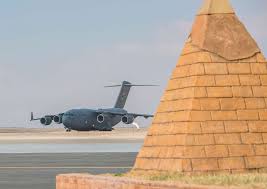
C-17 Landing Gear: Technical Guide
The Critical Role of C-17 Landing Gear
The C-17 Globemaster III is a military transport aircraft developed for strategic airlift missions. One of its most vital systems is the landing gear. Responsible for supporting the weight of the aircraft during takeoff, landing, and taxiing, the landing gear functions under immense stress. Designed with durability and efficiency in mind, each component works together to ensure successful missions.
Design and Operation
The C-17’s landing gear consists of a tricycle arrangement. This includes dual-wheeled nose gear and dual-tandem main landing gear assemblies. These systems support the aircraft’s massive weight, which can exceed 580,000 pounds when fully loaded. The nose gear steers the aircraft on the ground, while the main gear absorbs landing impact and redistributes it evenly.
Materials used in constructing the landing gear must withstand stresses and harsh environments. Titanium, due to its strength and lightweight properties, is a common choice for structural components. Additionally, advanced alloys and composite materials contribute to reduced weight while ensuring durability.
Hydraulic Systems and Retraction
The C-17’s landing gear operates using an intricate hydraulic system. This system deploys and retracts the components with precision. Hydraulic fluid, under pressure, moves pistons connected to the landing gear. This mechanism controls extension and retraction, allowing smooth operation during flight and landing.
Hydraulic actuators play a crucial role in this process. Actuators convert hydraulic pressure into mechanical energy, which facilitates gear movement. The system’s redundancy ensures reliability even if one component fails—the gear can still deploy using backup hydraulic circuits.
Braking System
The braking system is integral to the C-17’s landing gear. Featuring multi-disc brakes on the main wheels, this system provides necessary stopping force. Anti-skid capabilities prevent wheel lock-up, ensuring optimal control during landing. This feature is particularly important on wet or icy runways.
Heat generation during braking is a concern addressed through specific design strategies. Brake pads made from carbon composites resist high temperatures. Heat dissipation features in the wheels help manage the intense frictional heat produced.
Shock Absorbers and Oleos
The C-17’s shock absorption relies on oleo struts. These components combine compressed air and hydraulic fluid to absorb impact forces. During landing, oleos compress, cushioning the aircraft and passengers from abrupt forces. This technology reduces stress on airframe structure and enhances comfort.
Maintenance of these struts is crucial. Regular checks for hydraulic fluid levels and air pressure ensure consistent performance. Wear and tear must be monitored to prevent potential failures or inefficiencies.
Landing Gear Safety Features
Safety is paramount in landing gear design. The C-17 includes several features to enhance operational safety. Gear position indicators inform pilots of landing gear status—extended or retracted. This information is crucial, especially when visual confirmation is difficult.
In emergency scenarios, manual gear extension capabilities exist. A backup mechanical system allows pilots to deploy the gear manually if hydraulic systems fail. Additionally, built-in safety interlocks prevent accidental retraction while on the ground.
Maintenance and Inspection
Regular maintenance of the landing gear is a part of the C-17’s operational protocol. Inspections examine structural integrity, checking for cracks, corrosion, or other damage. Lubrication of mechanical parts reduces friction and wear. Hydraulic lines and connections are scrutinized for leaks or blockages.
Inspection protocols follow a strict schedule based on flight hours and calendar time. Advanced diagnostic tools aid technicians in assessing the state of the gear. Preventive maintenance practices are essential to ensure reliability and extend service life.
The Future of Landing Gear Technology
Advancements in technology are shaping the future of landing gear systems. The integration of smart sensors can offer real-time monitoring. Sensors are being explored to provide data on stress loads and component health. This could lead to predictive maintenance, reducing unplanned downtime.
Lightweight materials and advanced manufacturing techniques are also under research. Exploring materials that offer greater strength without adding weight can improve efficiency. Additive manufacturing presents possibilities for creating complex structures, enhancing performance and resilience.